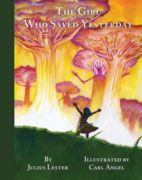
The Girl Who Saved Yesterday
Written by Julius Lester
Illustrated by Carl Angel
Creston Books, 2016, 32 pp.
ISBN: 9781939547248
Award winning author Julius Lester pays homage to ancestors in this fable about a girl named Silence who is exiled to the forest by villagers for attempting to find her deceased mother and father. The villagers fear that if Silence climbs to the top of the mountain where the dead are buried, fire will be sent down to destroy them. Left deep in the forest as a small baby, Silence is adopted and raised by personified trees. There she stays, nestled in their branches, until Wonderboom, the most ancient of trees sends her back to the village to save Yesterday.
Silence is carried to the outskirts of the village by ThunderSnow, and placed at the foot of a tree that was made ill by Yesterday. Illustrator Carl Angel paints a vivid picture of what happens to a village when its ancestors have been forgotten. The Sun disappears and Darkness spreads across the pages of the book. Wild animals seek refuge in blackened caves and the topography turns a muted gray. Once in the village, Silence has to trust her intuition to reunite the living with the dead. Reprieve does not come until she makes her way to the top of the mountain to the gravestones of the ancestors. The villagers follow Silence with scythes and uncover stones that reveal bright lights, “like lost memories, happy to be found” (p. 30).
While Julius Lester does not name a specific tribe, in many African kin groups ancestors are believed to be intermediaries or to have mystical powers that could help their living kinsmen. Like other world cultures, Africans across the diaspora revered and communed with the dead. However, the pre-colonial status of African ancestors was challenged and dismissed by western missionary religions that considered these practices to be idolatry. In the author’s note, Lester dedicates this story to, “the Ancestors who have lived with and in me since I was born.” He emphasizes the importance of remembering and of being remembered.
Different cultures have unique ways of remembering their ancestors. One of the best ways to help students understand and respect the beliefs and practices of global cultures is to introduce them to books rich with stories and pictures. Books that would pair well with The Girl Who Saved Yesterday include The Day of the Dead/El Dia de Los Muertos by Bob Barner (2011); Sori’s Harvest Moon Day : A Story of Korea by Lee Uk-Bae (1999) and A Banquet for Hungry Ghosts: A Collection of Deliciously Frightening Tales (Ying Change Compestine (2009), all of which address the connection of the living with their ancestry.
Julius Lester is an African American writer and an academic. He published his first two works of children’s literature, To Be a Slave, a Newbery Honor Book, and Black Folktales in 1969. Over the course of his career, he has written more than 30 books for children. He has received the Boston Globe-Horn Book, The New York Times Outstanding Book Award and Coretta Scott King Book Award among others.
Carl Angel is a Filipino-American illustrator who grew up in Honolulu, Hawaii. He is also the illustrator of Xochitl and the Flowers (2013), Sky High: The True Story of Maggie Gee (2009), Lakas and the Manilatown Fish (2003), and Lakas and the Makibaka Hotel (2006).
Desiree W. Cueto, Western Washington University, Bellingham, WA
WOW Review, Volume VIII, Issue 4 by Worlds of Words is licensed under a Creative Commons Attribution-NonCommercial-ShareAlike 4.0 International License. Based on work at https://wowlit.org/on-line-publications/review/viii-4/
